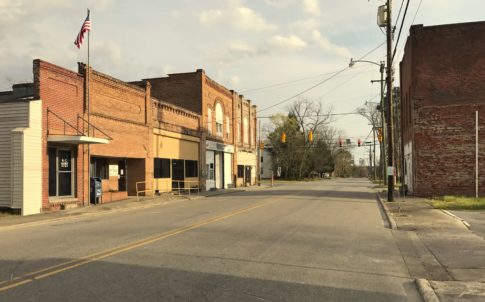Why rural is hard to define

What determines if an area is rural or not? Why is it relevant to distinguish between urban and rural at all? In this post, we talk about why defining rural areas is difficult, and how doing so correctly can improve the lives of those who live within them.
Part of the difficulty lies in picking a definition. The variety of criteria is representative of just how complex of a topic this can be.
The U.S. Census Bureau defines rural as “an area that is not urban”.
So, what do they consider to be urban? An area which contains more than 50,000 people. Slightly less populated areas, those with greater than 2,500 but less than 50,000, are determined to be “urban clusters.” Any area of land that is not put into one of these categories would be considered rural.
This definition is mainly calculated by population density, though it is important to note that land cover and even airport location data are considered as well.
The Census Bureau updates the rural-urban classifications once a decade, following the decennial census. Thirty-four percent of North Carolina’s population was rural in 2010. The Bureau has not yet released calculations based on the 2020 Census, and considering changes in the classification criteria, but we expect this share to decrease due to patterns of growth observed over the decade.
The Office of Management and Budget (OMB) takes a different approach to defining areas based on population density. According to the OMB, counties which are directly associated to an urbanized area containing 50,000 or more people are identified as metropolitan statistical areas (MSA). Counties which are associated with an urban area of greater than 10,000 but less than 50,000, are referred to as micropolitan statistical areas. In addition, counties in which 25 percent of the population commutes to an MSA are also considered to be metro areas.
As of March 2020, there are 384 metropolitan statistical areas and 543 micropolitan statistical areas in the United States. North Carolina is home to 15 of the former, and 26 of the latter.
The US Department of Agriculture (USDA) takes on multiple methodologies within the same organization. Each one is program specific. For example, their Telecommunications Loan Program recognizes any area with less than 5,000 residents to be rural. At the same time, they have many other initiatives that categorize areas with up to 50,000 residents to be rural, as well.
We occasionally use the definition of rural provided by the NC Rural Center. They define rural as a population density of 250 people per square mile or less. By this definition, 78 North Carolina counties out of 100 are classified as rural using 2020 Census data. (Two counties, Johnston and Onslow, transitioned from rural to urban under this definition between 2010 and 2020.)
No one definition is “more correct,” so to speak. The existence of multiple methodologies allows for flexibility when applying the classifications.
The Census Bureau and OMB definitions are mainly used for statistical analysis. They provide clear cut delineations of rural versus urban areas, even though they do so differently. The Health Research Services Administration notes that the OMB definition likely undercounts rural areas while the Census Bureau definition overcounts them.
On the other hand, the USDA’s flexibility allows for programs to target specific populations more effectively. For example, the Telecommunications Loan Program’s goal is to provide more areas with high-speed internet and reliable communication networks. They determine that 5,000 people is the threshold because studies have shown that those are the locations that need the most assistance with telecommunications infrastructure. Other USDA programs identify rural using issue-specific literature. Having an intentional target population increases the effectiveness of their policy or program.
A large body of research has identified differences in economics, geography, demographics, and even culture between rural and urban areas. These community-defining characteristics have significant implications for legislative efforts at all levels of government.
We can see some of these differences in the following areas:
Rural areas across the US and across North Carolina are shrinking. Over the last decade, 51 counties in North Carolina lost population and many of these losses were in more rural counties in the Sandhills and Northeast regions of the state.
Migration patterns also vary significantly between the two locales. Nationally, urban areas have been rapidly gaining population by way of immigration, and suburban areas mainly through domestic migration. Rural areas, however, have a larger number of people exiting than they do moving in.
Pew notes that “older adults are a higher share of the population in rural areas than in urban and suburban counties.”
An analysis from the Rural Health Research Project at UNC-Chapel Hill found that at least 181 rural hospitals have closed or stopped in-patient services nationwide since 2005. We also see a gap in job availability and wages: Analysis from the Agricultural Policy Review at Iowa State University found that rural areas had lower monthly labor force participation rates from January 2019 through May 2020. They attribute this to a variety of factors, including “differing employment opportunities, age structure, [and] gender norms.”
The Economic Research Service at the U.S. Department of Agriculture notes, “From its post-recession low, in 2010, to 2017, rural wage and salary employment has grown at an average annual rate of 0.5 percent, compared to 1.8 percent in urban areas.”
The Pew Research Center found that a quarter of people living in rural areas have said access to high-speed internet is a major problem. (An additional 34% of people living in rural areas say high-speed access is a minor problem – both categories are much greater than urban and suburban counterparts.)
Broadband internet access and availability is more variable in less densely populated regions, which has become increasingly apparent throughout the pandemic as adults and children have pivoted to online work and instruction. North Carolina tracks broadband availability and adoption across the state.
The Census Bureau reclassifies urban versus rural after every decennial census (released every 10 years). The reclassification data will be released in 2022 (date TBA).
The 2010 census identified 3,573 urban areas nationwide representing roughly 81 percent of the U.S. population at the time. In contrast, 97 percent of the country’s land area is deemed rural while holding less than 20 percent of the country’s population.
North Carolina’s population was 66 percent urban in 2010 and this proportion will likely increase. The 2020 census shows some of the state’s more rural counties have seen declines in population relative to 2010 counts – Tyrell (-26%), Hyde (-21%), Anson (-18%) – to name a few, while more urban areas continue to rise – Wake (+25%), Durham (+21%), Mecklenburg (+21%).
Though many rural areas have lost population, other rural counties, particularly those located near larger urban areas, have increased in population. Areas within counties such as Pender, where an increase of 15% was observed over the last 10 years, are becoming quickly developed workers in neighboring cities like Wilmington seek housing. These changes will also increase the state’s urban population, as places that were previously classified as rural see their classification change to urban.
Need help understanding population change and its impacts on your community or business? Carolina Demography offers demographic research tailored to your needs.
Contact us today for a free initial consultation.
Contact UsCategories: NC in Focus

The Center for Women’s Health Research (CWHR) at the University of North Carolina School of Medicine released the 12th edition of our North Carolina Women’s Health Report Card on May 9, 2022. This document is a progress report on the…

Dr. Krista Perreira is a health economist who studies disparities in health, education, and economic well-being. In collaboration with the Urban Institute, she recently co-led a study funded by the Kate B. Reynolds Foundation to study barriers to access to…

Our material helped the NC Local News Lab Fund better understand and then prioritize their funding to better serve existing and future grant recipients in North Carolina. The North Carolina Local News Lab Fund was established in 2017 to strengthen…
Your support is critical to our mission of measuring, understanding, and predicting population change and its impact. Donate to Carolina Demography today.